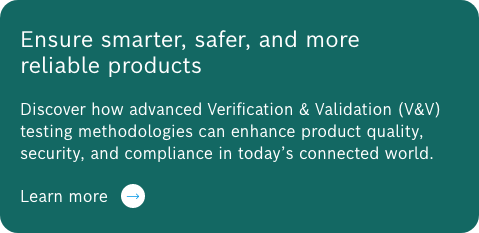Smarter Testing for an Autonomous Future: How SIL is Powering Risk-Free Validation

Summary
Industries are advancing toward fully autonomous systems, ensuring software reliability is more critical than ever. SIL testing offers a simulated environment for early-stage software validation, enabling rigorous, risk-free assessment of complex systems. Discover why SIL testing is a cornerstone of software development and how a strategic approach can maximize its full potential.
Introduction
With increasing software complexity, ensuring reliability and safety before deployment is more challenging than ever. As systems grow more intricate, industries grapple with longer testing cycles, difficult debugging, unpredictable behavior, and mounting integration challenges. These complexities, coupled with regulatory scrutiny, rising development costs, and tighter go-to-market timelines,make traditional validation methods inadequate.
SIL (Software-in-the-Loop) testing emerges as a futuristic solution, providing a controlled, virtual environment to rigorously test complex software systems in isolation. By simulating real-world conditions without the need for physical hardware, SIL enables early defect detection, efficient test coverage, and reduced development costs. This makes it particularly valuable for safety-critical applications, where compliance with stringent regulations demands thorough validation.
Looking ahead, SIL testing is set to play an even greater role in accelerating development, enhancing software reliability, and ensuring seamless integration across industries.
How does SIL testing drive smarter, safer software?
As intelligent solutions—autonomous vehicles, industrial automation, etc.—become more pervasive, SIL simulations have become indispensable for embedded system validation. By decoupling software validation from physical constraints, SIL accelerates innovation, enhances safety, and reduces costly late-stage failures across industries.
For instance, in the automotive industry, it helps ensure that ADAS and autonomous vehicle software meet functional and performance requirements before deployment, while also enhancing virtual electronic control unit (vECU) testing to detect and resolve software issues before integration.
Beyond mobility, SIL plays a crucial role in other industries. In consumer electronics, it enhances the reliability of smart home systems, IoT devices, and AI-driven products, ensuring seamless performance in diverse conditions. In medical technology, SIL is vital for verifying the safety and accuracy of life-critical applications, such as patient monitoring systems and robotic surgical devices. Likewise, it plays a key role in industrial automation, helping validate PLCs, robotics, and factory automation software and ensuring smooth integration and efficient operation.
Building a high-fidelity SIL test environment
A robust SIL test environment should have these four elements:
- System under test (SUT): The software application or code being tested, which is the primary focus of the SIL simulation.
- Environment simulation models: Detailed representations of the system’s environment, including sensors, actuators, and other relevant components, are used to provide realistic inputs to the SUT during testing.
- Simulation and integration platform: The software tool or environment that executes the simulation models and interacts with the SUT, allowing for controlled testing conditions and data analysis.
- Validation environment: A set of defined test conditions and scenarios designed to thoroughly evaluate the SUT’s behavior under various operating situations, including edge cases and potential failures.
These components work together to enable comprehensive testing of software behavior in various scenarios without real-world hardware interaction. However, the scope and requirements vary based on the software being tested.
But how can the software be embedded into a virtual environment when it demands integration expertise? The key lies in leveraging advanced co-simulation frameworks, middleware solutions, and standardized data exchange protocols to create a seamless interface between the SUT and its virtual surroundings. This approach expedites testing cycles and also enhances adaptability, allowing for iterative refinements in a risk-free environment.
Confronting the challenges of SIL environments
While SIL environments offer immense potential for software validation, setting them up and maintaining their effectiveness comes with significant challenges. Organizations must address both technical and operational hurdles to ensure SIL testing delivers scalable and cost-effective results.
- Technical complexities in SIL testing
Developing an effective SIL environment requires deep expertise in simulation modeling, software-hardware interactions, and real-world system dynamics. One of the biggest challenges lies in accurately representing real-world conditions, especially when multiple systems interact in complex ways. Ensuring that the SIL environment precisely replicates hardware behavior is critical to uncovering software vulnerabilities and enhancing system reliability. Additionally, real-time processing constraints, latency, and concurrency must be meticulously accounted for to create a testing ecosystem that truly reflects real-world performance. Without these elements, the effectiveness of SIL simulations in predicting software behavior is significantly diminished. -
Operational barriers to SIL adoption
Beyond technical hurdles, managing and scaling SIL environments presents several operational challenges. Test case prioritization is crucial, as identifying and focusing on the most critical scenarios ensures efficient use of resources and maximizes overall test coverage. Expanding SIL environments to support larger and more complex simulations, however, can be both technically and financially demanding. The investment required to develop, maintain, and scale SIL infrastructure is substantial, making cost optimization a key factor in long-term sustainability. Balancing test coverage, scalability, and financial constraints is essential to maximize the potential of SIL testing.
Strategies and solutions for effective SIL testing
To maximize the effectiveness of SIL testing, organizations need well-defined strategies. By leveraging automation, advanced simulation techniques, and optimized resource management, companies can establish a robust SIL environment that accelerates software validation while minimizing costs. Key solutions include:
- High-fidelity simulation models: Invest in simulation models that leverage predictive analytics to ensure the SIL environment mirrors real-world behavior, improving test reliability and uncovering hidden software vulnerabilities. Advanced modeling techniques allow for better replication of sensor data, environmental factors, and hardware responses, leading to more precise validation outcomes.
- Integrated testing: Combine SIL with Hardware-in-the-Loop (HIL) testing to bridge the gap between virtual simulations and real-world system behaviors, strengthening software validation. This hybrid approach enables real components to interact with simulated environments, ensuring seamless software-hardware integration and improving accuracy in safety-critical applications.
- Modular testing: Implement a setup that allows individual components or subsystems to be validated independently before full system integration, reducing complexity and accelerating development. This structured approach enhances troubleshooting, minimizes rework, and enables incremental validation, leading to faster and more efficient software iterations.
- Communication protocols: Use standardized protocols to enhance compatibility between different tools and platforms within the SIL environment, streamlining the testing process. Ensuring seamless interoperability reduces integration overhead, allowing for more flexible and efficient test setups.
- Automated testing: Leverage cloud-based simulation platforms to reduce infrastructure costs and improve the scalability of SIL environments. Automating test scenarios optimizes resource utilization, enabling broader test coverage without escalating expenses. By minimizing manual intervention and accelerating test cycles, automation ensures a cost-effective, high-performance validation process.
The urgency to adopt these best practices cannot be overstated—efficient SIL testing is critical for delivering high-performance, future-ready software. By integrating these strategies cohesively, organizations can transform SIL testing into a scalable, high-precision validation framework that keeps pace with evolving software complexity and industry demands.
Embrace SIL testing for an autonomous future
Industries are rapidly advancing toward automation and intelligent systems, making SIL testing essential for ensuring software performance. However, its effectiveness hinges on scalable implementation, seamless integration, and precise real-world simulation. A structured approach is necessary—one that aligns technical depth with operational efficiency.
A well-executed SIL framework accelerates validation cycles and enhances software resilience in safety-critical applications. Bosch SDS enables industries to build scalable, high-fidelity SIL environments that improve testing accuracy and efficiency. As the demand for advanced validation grows, the focus must remain on developing adaptable, cost-effective testing ecosystems that drive innovation without compromising reliability.








